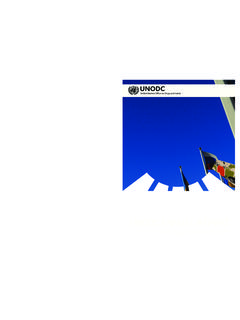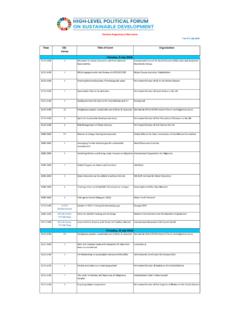Transcription of FAO STRATEGY ON CLIMATE CHANGE
1 Rome, July 2017 FAO STRATEGY ON CLIMATE CHANGE2 MYANMARC arrying a sack of fertilizer distributed by FAO as part of a project to support sustainable livelihoods for flood-affected communities in the Sagaing region. FAO/H. LatCOVER PHOTOGRAPHS: FAO/Joseph Agcaoili FAO/Christena Dowsett FAO/Giuseppe Bizzarri3 ContentsACRONYMS AND ABBREVIATIONS Page 4 FOREWORD Page 6 EXECUTIVE SUMMARY Page 8 INTRODUCTION Page 11 The agricultural sectors, the Paris Agreement and beyond Page 11 CLIMATE CHANGE impact - food and agriculture Page 13 SECTION 1 CLIMATE WORK AT FAO Page 14 Evolution Page 14 Vision Page 15 Approach Page 15 SECTION 2 GUIDING PRINCIPLES Page 17 Give precedence to food security.
2 Poverty reduction and sustainability Page 17 Leave no one behind Page 17 Support policy integration and mainstreaming Page 17 Promote evidence-based, scientific approaches Page 18 Promote ecosystem-based approaches Page 18 Learn from experience Page 18 Lead by example Page 18 Measure and evaluate impact Page 18 SECTION 3 EXPECTED OUTCOMES Page 19 Outcome 1. Enhanced capacities of Member Nations on CLIMATE CHANGE through FAO leadership as a provider of technical knowledge and expertise Page 19 Outcome 2.
3 Improved integration of food security and nutrition, agriculture, forestry and fisheries considerations within the international agenda on CLIMATE CHANGE through reinforced FAO engagement Page 19 Outcome 3. Strengthened coordination and delivery of FAO work on CLIMATE CHANGE Page 19 SECTION 4 PLAN OF ACTION Page 20 ANNEX 1: THE IMPACTS OF CLIMATE CHANGE ON THE FOOD AND AGRICULTURAL SECTORS Page 28 Food security Page 28 Nutrition and human health Page 29 The agricultural sectors Page 29 Natural resources Page 31 Post-production stages Page 33 Human migration Page 33 ANNEX 2: ACTION PLAN RESULTS FRAMEWORK Page 36 ANNEX 3.
4 RESOURCE ALLOCATION Page 45 FAO STRATEGY ON CLIMATE CHANGE4 Acronyms and abbreviations AFOLUA genda 2030 CBCCBDCCAMCO2 COP21 COP22 CPFsCSADRRFAOGCFGDPGEFGHGhaIDWG CCIFADA griculture, Forestry and Land Use 2030 Agenda for Sustainable Development FAO CLIMATE and Environment Division (in the CLIMATE , Biodiversity, Land and Water Department) Convention on Biological DiversityClimate CHANGE Adaptation and Mitigation Carbon Dioxide 21st Conference of the Parties to the UNFCCC 22nd Conference of the Parties to the UNFCCC Country Programming Frameworks CLIMATE -Smart Agriculture Disaster Risk Reduction Food and Agriculture Organization of the United Nations Green CLIMATE Fund Gross Domestic Product Global Environment Facility Greenhouse Gas Hectares Interdepartmental Working Group on CLIMATE CHANGE International Fund for Agricultural
5 Development ACRONYMS AND ABBREVIATIONS5 IFIsINDCsIPCCLDCsLLDCsLULUCFMTPNAMAsNAPs NDCNRCPWBSDGsSFMSIDSSPsTNCCCO2e/ha/yearU NUNCCDUNDPUNEPUNFCCCWFPWMOI nternational Financial Institutions Intended Nationally Determined Contributions Intergovernmental Panel on CLIMATE CHANGE Least Developed Countries Land-Locked Developing CountriesLand Use, Land Use CHANGE and Forestry Medium Term Plan Nationally Appropriate Mitigation Actions National Adaptation Plans Nationally Determined Contributions FAO CLIMATE and Environment Division (since December 2016 known as CBC)
6 Programme of Work and Budget Sustainable Development Goals Sustainable Forest Management Small Island Developing States FAO Strategic Programmes FAO Technical Network on CLIMATE CHANGE Tonnes of carbon dioxide equivalent per hectare per year United Nations United Nations Convention to Combat Desertification United Nations Development Programme United Nations Environment Programme United Nations Framework Convention on CLIMATE CHANGE World Food Programme World Meteorological OrganizationFAO STRATEGY ON CLIMATE CHANGE6 FOREWORDFOREWORDF orewordThere is no peace without tackling food security and eliminating hunger and there will be no food without tackling CLIMATE CHANGE .
7 I am convinced that we can end hunger in our lifetime. We have the tools and the know-how. However, the goals and aspirations of the 2030 Agenda for Sustainable Development to end hunger, reduce rural poverty and manage natural resources in a sustainable manner cannot be achieved if temperatures continue to rise. We have a window of opportunity to stabilize global average temperatures to safe levels but we must act now. Now is the time to take action to meet the target included in the Paris Agreement of the UN Framework Convention on CLIMATE CHANGE .
8 That is why CLIMATE action, a cross-cutting theme of FAO s Strategic Framework, is being integrated into every facet of our work, bolstering and building on decades of accumulated global experience and expertise. Agriculture and food systems are partly responsible for increased temperatures but are also a fundamental part of the solution to mitigate greenhouse gas emissions and promote adaptation to a changing CLIMATE , especially for rural family farmers in developing countries. Often the poorest, they are also the most vulnerable to CLIMATE CHANGE .
9 For millions of people, our actions can make a difference between poverty and prosperity, between hunger and food the impacts of CLIMATE CHANGE increase and become more intense, a global transformation to sustainable agriculture must begin immediately. Noting that around 90 percent of the countries CLIMATE commitments, known as Nationally Determined Contributions (NDCs), include the agricultural sectors clearly demonstrates the strong demand from FAO Member Nations for CLIMATE action and also underlines that FAO has a fundamental contribution to considers CLIMATE CHANGE a top-line corporate priority - as reflected in the newly-endorsed STRATEGY on CLIMATE CHANGE where FAO will focus its work on three fronts.
10 First, to enhance institutional and technical capacities of Member , to improve integration of food security, agriculture, forestry and fisheries within the international CLIMATE third, to strengthen internal coordination and delivery of FAO s STRATEGY translates FAO s core mandate into strategic choices and action priorities at global, regional, national and local levels with the central goal of supporting its Member Nations in achieving their commitments to face CLIMATE CHANGE . It will be implemented through FAO s Strategic Framework as well as through strategic partnerships.















